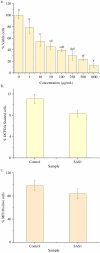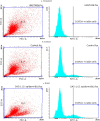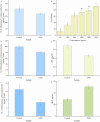Staphylococcus epidermidis SAS1: new probiotic candidate for obesity and allergy treatment their mechanistic insights and cytotoxicity evaluation
- PMID: 40371109
- PMCID: PMC12075200
- DOI: 10.3389/fmicb.2025.1546687
Staphylococcus epidermidis SAS1: new probiotic candidate for obesity and allergy treatment their mechanistic insights and cytotoxicity evaluation
Abstract
Background: Probiotics are live bacteria that provides numerous healthy and beneficial effects to the consumers. The present study aimed to investigate the effect of a probiotic candidate Staphylococcus epidermidis SAS1, in immunoregulation and obesity management.
Methods: : This probiotic candidate was isolated from a soil sample collected from a region of fruit waste decomposition. In vitro cytotoxicity was assessed using the THP-1 (human leukemia monocytic cell line) cells using MTT assay.
Results: An IC50 value of 47.52 ± 0.18 μg/mL and cell shrinkage were observed along with the release of cellular content of THP-1 cells. The higher production of reactive oxygen species and lesser release of interleukins (IL-4, 5, and 13) are attributed to the antiallergic potential of this strain. Furthermore, in vitro cytotoxicity evaluation using 3T3-L1 cells identified this strain as a promising candidate for anti-obesity treatment. The observed IC50 value was 514.4 ± 0.061 μg/mL.
Discussion: This extract was shown to have good lipase-inhibiting enzyme activity and was reported to prevent adipogenesis, depicted by increased HDL levels and decreased LDL and triglyceride levels. These results suggested that Staphylococcus epidermidis SAS1 may have therapeutic use in the treatment of obesity and allergies.
Keywords: Staphylococcus epidermidis; allergy; obesity; probiotic candidate; therapeutic treatment.
Copyright © 2025 Sharma, Sharma, Sodhi, George, Alarjani, Mukherjee, Kumar Rath, Kaur and Dwibedi.
Conflict of interest statement
The authors declare that the research was conducted in the absence of any commercial or financial relationships that could be construed as a potential conflict of interest.
Figures







Similar articles
-
Isolation, Screening, and Identification of Staphylococcus epidermidis with Effective Probiotic Attributes.Curr Microbiol. 2025 Apr 7;82(6):235. doi: 10.1007/s00284-025-04206-0. Curr Microbiol. 2025. PMID: 40192816
-
Comparative biological study of roots, stems, leaves, and seeds of Angelica shikokiana Makino.J Ethnopharmacol. 2013 Jul 30;148(3):980-7. doi: 10.1016/j.jep.2013.06.008. Epub 2013 Jun 12. J Ethnopharmacol. 2013. PMID: 23769982
-
Selection and Characterization of Probiotic Bacteria Exhibiting Antiadipogenic Potential in 3T3-L1 Preadipocytes.Probiotics Antimicrob Proteins. 2022 Feb;14(1):72-86. doi: 10.1007/s12602-021-09793-5. Epub 2021 May 7. Probiotics Antimicrob Proteins. 2022. PMID: 33961206 Free PMC article.
-
Beneficial Effects of Probiotic Consumption on the Immune System.Ann Nutr Metab. 2019;74(2):115-124. doi: 10.1159/000496426. Epub 2019 Jan 23. Ann Nutr Metab. 2019. PMID: 30673668 Review.
-
Staphylococcus epidermidis Controls Opportunistic Pathogens in the Nose, Could It Help to Regulate SARS-CoV-2 (COVID-19) Infection?Life (Basel). 2022 Feb 25;12(3):341. doi: 10.3390/life12030341. Life (Basel). 2022. PMID: 35330092 Free PMC article. Review.
References
-
- AboNahas H. H., Darwish A. M., Abd EL-Kareem H. F., Abonahas Y. H., et al. . (2022). “Trust your gut: the human gut microbiome in health and disease” in Microbiome-gut-brain axis. eds. Sayyed R. Z., Khan M. (Singapore: Springer; ), 53–96.
-
- Bergey D. H. (1994). Bergey's manual of determinative bacteriology. Philadelphia: Lippincott Williams & Wilkins.
LinkOut - more resources
Full Text Sources

